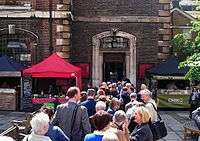Royal Academy Summer Exhibition


The Summer Exhibition is an open art exhibition held annually by the Royal Academy in Burlington House, Piccadilly in central London, England, during the summer months of June, July, and August. The exhibition includes paintings, prints, drawings, sculpture, architectural designs and models, and is the largest and most popular open exhibition in the United Kingdom.[1]
When the Royal Academy was founded in 1768 one of its key objectives was to establish an annual exhibition, open to all artists of merit, which could be visited by the public.
The first Summer Exhibition took place in 1769; it has been held every year since without exception.[1]
Today, around 1,000 works are selected each year from as many as 10,000 entries representing some 5,000 artists. Any artist (living, known or unknown) may submit up to two works at a fee of £25 per piece for selection by The Summer Exhibition Selection and Hanging Committee. Due to the significant increase in the volume of entries over recent years, the number of entries per artist was reduced to 2 (from 3) and the fee was increased £18 per piece. The committee is formed from the Council of Academicians (the governing body of the RA) and is traditionally chaired by the President of the Royal Academy. In addition to those works selected by the committee, all 80 Academicians are entitled to have six of their own pieces in the exhibition.
The 2005 exhibition theme was "Printmaking and the multiple". In 2006, the theme was "From Life." In 2008, the theme was "Man Made". The theme for 2010 was "Raw".[2] In 2011, the selection committee agreed to have no specific theme.
For the 2006 exhibition, the academy received a statue and a plinth from David Hensel. By mistake, the two parts were judged independently, with the result that the statue was rejected and the plinth put on display.[3]


The RA Summer Exhibition usually opens to the public in early June, preceded by a series of private viewings. The main event is called "Varnishing Day", the day that, according to popular legend, artists would come to add a final coat of varnish to their paintings (compare: vernissage). Traditionally, artists walk in procession from Burlington House to St James's Church, Piccadilly, where a service is held. At the opening reception the shortlists for various prizes are announced.
Over £70,000 prize money, including the £25,000 Charles Wollaston Award, is awarded each year at the Summer Exhibition. Winners include R.B. Kitaj (1997), David Hockney (1999), Gerard Hemsworth (2000), Marc Quinn (2001), Jake and Dinos Chapman (2003),[4] Chantal Joffe (2006), Gavin Turk (2007), Jeff Koons (2008), Richard Wilson (2009), Yinka Shonibare (2010), Alison Wilding (2011),[5] Anselm Kiefer (2012), El Anatsui (2013)[6] and Wolfgang Tillmans (2014).[7] In addition, a £10.000 architectural prize is awarded.[8]
Almost all exhibited works are for sale; the Academy receives 30% of the purchase price. In 2003, this amounted to a sum of some £2,000,000 for the institution, which receives no financial support from the state or crown.
References
- 1 2 "The Royal Academy of Arts Summer Exhibition 2011". Culture, The Telegraph. UK. 2 June 2011. Retrieved 4 July 2011.
- ↑ Summer Exhibition 2010, Royal Academy of Arts, 2010.
- ↑ Sally Pook (2006-06-15). "Artist laughs his head off at the RA". The Telegraph.
- ↑ "Chapman brothers win £25,000 prize", The Guardian, 27 June 2003.
- ↑ "Alison Wilding wins the Charles Wollaston Award 2011", cornerhousepublications.org, 20 June 2011.
- ↑ "El Anatsui wins the prestigious Charles Wollaston Award for his work at the Royal Academy of Arts, 245th Summer Exhibition", octobergallery.co.uk.
- ↑ "Summer Exhibition 2014, Royal Academy of Arts", The Huffington Post, 24 June 2014.
- ↑ R. Waite, "Cash prizes return for Royal Academy Summer Exhibition", architectsjournal.co.uk, 22 Feb 2015.
| Wikimedia Commons has media related to Royal Academy summer exhibition. |
Further reading
- Staley, A., ed. (1975). The Royal Academy (1837–1901) revisited: Victorian paintings from the Forbes magazine Collection. New York: The Metropolitan Museum of Art. (see index)